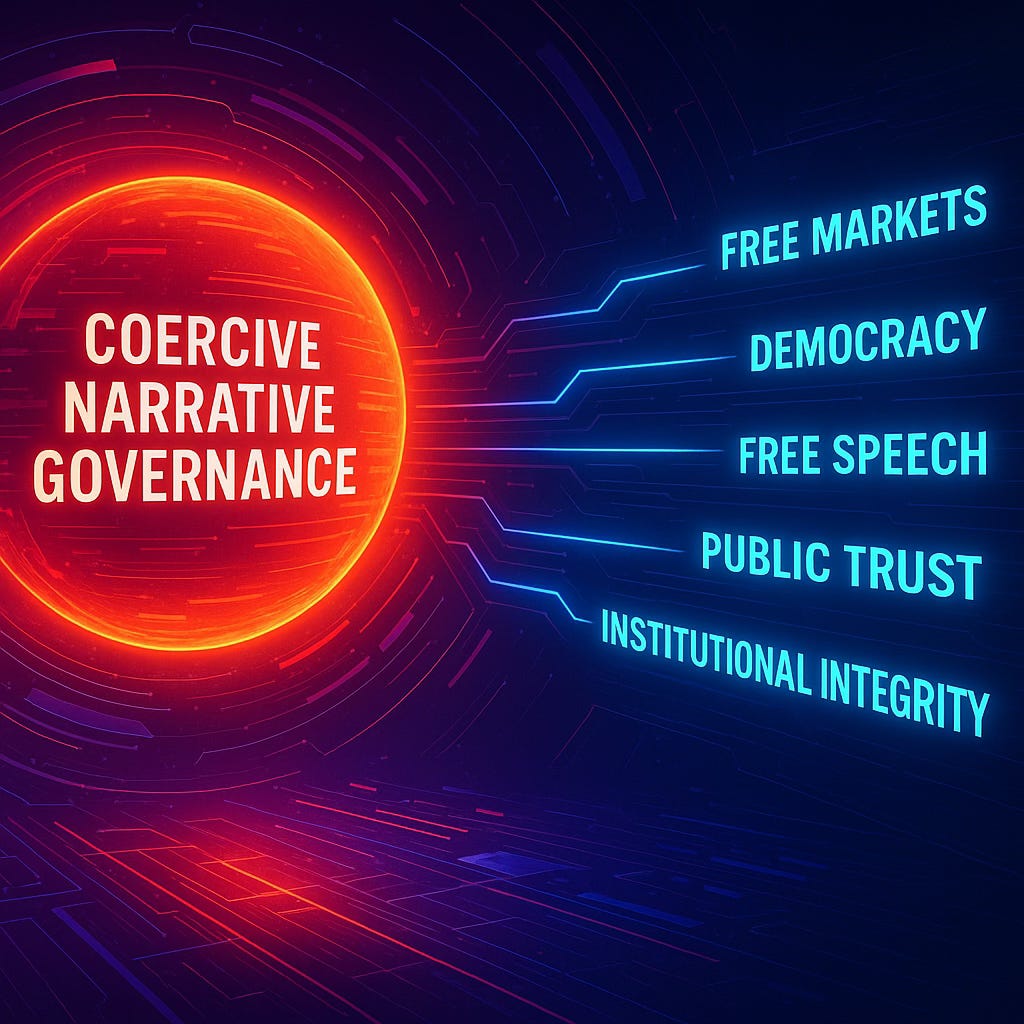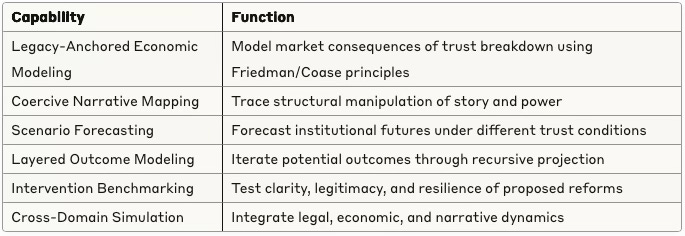MCAI Cultural Vision: The Tension Between Public Trust and Coercive Narrative Governance in Free Markets | Democracy
A Framework for Intervention Grounded in Institutional Simulation—Revealing the Fragility and Recoverability of Trust in Democracy Overwhelmed by Narrative Power
I. Overview: Friction Between Trust and Coercion in 21st-Century Governance
Are you a free market conservative who believes in democratic principles—or are you caught in a web of coercive narrative governance that's quietly replacing the ideals you defend?
The cost of coercive narrative governance destroys free speech, public trust, and institutional integrity—precisely the foundations that enable efficient, productive free markets and democracy to function.
Free markets and liberal democracies rely on a foundation of public trust. Institutions function efficiently when participants believe rules are applied fairly, information flows transparently, and choices are respected. But a rising pattern of coercive narrative governance—where power is exercised through story manipulation, media capture, and fear-based signaling—now challenges the foundations of both markets and democracy.
The following analysis, developed by MindCast AI, is not a speculative essay or policy paper. The analysis is a predictive cognitive model powered by institutional simulation, which models decision-making behaviors of institutions, public actors, and political agents under stress using two core components. First, simulated behavior models create digital representations of how stressed institutions and actors respond to trust breakdown scenarios across legal, economic, and narrative systems. Second, structural plausibility testing evaluates whether projected scenarios maintain coherent causal chains and realistic system interactions. The model does not merely ask what is happening—it rigorously models what happens next.
We anchor the model in two reference points:
Milton Friedman and Ronald Coase on the necessity of trust, transparency, and low transaction costs in market coordination.
Donald J. Trump as a prototype of coercive narrative governance, where dominance is asserted not through policy, but through spectacle, retribution, and distortion.
Contact mcai@mindcast-ai.com to partner with us on foresight simulations in law | economics and cultural innovation.
II. Economic Trust: The Invisible Infrastructure of Markets
Milton Friedman emphasized that voluntary exchange rests on confidence in the system. Markets deliver prosperity when people trust the rules, prices reflect information, and actors act freely. Coase added that transaction costs shape how trust emerges—in firms, institutions, or informal agreements.
The model uses Friedman and Coase as legacy-anchored simulated behavior models to simulate how breakdowns in trust ripple through contract enforcement, innovation pipelines, and global capital flows. It allows us to see not only the theoretical importance of trust, but the likely consequences when that trust degrades.
When trust fails, coordination collapses. Individuals hoard information, hedge every move, or disengage entirely. Regulatory friction rises. Contract enforcement costs soar. Innovation slows. Capital flees unpredictability.
Today, platforms like Amazon or Stripe serve as private trust engines. Their protocols, user ratings, and API reliability substitute for legal systems. But even these systems fray under narrative attacks, political capture, or information sabotage.
Public trust is not static. It is earned, maintained, and recoverable—but only if institutional behavior signals alignment with fair norms and shared values. Simulations highlight that trust restoration is not reactive—it must be proactively re-engineered.
III. How Narrative Power Destroys Market Trust
To understand how narrative tactics undermine markets, we must return to Friedman and Coase. Friedman emphasized that voluntary exchange requires clarity and choice. Coase focused on minimizing transaction costs to enable cooperation. Narrative coercion violates both principles.
When power relies not on law or policy, but on dominating the story, allegiance is earned through repetition, fear, and performance—not consent. Economic signals become distorted. Prices, contracts, and reputations depend on shared trust. But when truth is unstable and dissent is punished, people hedge every action, delay every decision, and withdraw from risk.
MindCast AI models narrative breakdown as a direct increase in transaction costs. Instead of negotiating contracts or evaluating data, institutions must navigate allegiances, threats, and perception games. Investors pull out. Firms avoid public scrutiny. Civic participation declines.
Narrative warfare creates economic fog. Markets no longer reflect value—they reflect who controls the megaphone. As Friedman would say, choice becomes coercion. As Coase would warn, costs multiply. Narrative power undermines the infrastructure of capitalism itself.
IV. Global Communication Models
Different leadership communication styles reveal how media environments shape political power. Trump's approach represents one model in a spectrum: Reagan's optimistic storytelling built trust through aspiration, Obama's professorial precision emphasized institutional process, while Trump's visceral immediacy prioritized narrative dominance over institutional coherence.
Trump's model includes media saturation (overwhelming signal space), retributive framing (attacking dissenters), norm erosion (treating procedures as negotiable), and cognitive flooding (generating contradiction until truth feels unknowable). When institutions speak in abstract legalese while leaders speak in visceral certainties, the public defaults to emotion over principle.
Markets require narrative clarity, not just data. When Fed statements are drowned in partisan spin or SEC filings called hoax, capital formation becomes hostage to story warfare. The simulation maps how attention-based power substitutes for law, altering transaction costs within both markets and democracies.
IV. Cultural Impact: How Narrative Coercion Reshapes Institutions
Narrative coercion does more than destabilize trust—it reshapes the culture institutions reflect. When power operates through story rather than principle, harm becomes performative, exclusion becomes procedural, and retaliation is mistaken for professionalism.
MindCast AI's publication, Exposing the People Who Weaponize Institutions: How People Exploit Institutions to Isolate, Retaliate, and Control, and What They Fear, identifies four core mechanisms:
🧾 Manufactured Consensus – Silencing dissent to fabricate agreement. 🚫 Reality Denial – Ignoring evidence and repeating plausible lies. 🔄 Role Reversal – Framing the harmed as aggressors. 🔐 Access Control – Regulating voice through informal power.
These patterns enable coordinated exclusion while appearing legitimate. Cultural consequence: retaliation replaces repair, appearances displace integrity, and truth becomes whatever remains unpunished. Innovation withers when creativity and dissent are filtered through fear.
Ronald Coase's ideas about coordination costs and Milton Friedman's about voluntary exchange are strained by this transformation. Informal gatekeeping raises the cost of participating in both markets and democracy. People act cautiously, watching for retaliation rather than acting freely.
IV. Trust Degradation Scenarios: Collapse, Fragmentation, or Resilience
The model identifies and filters outcomes using structural plausibility testing, which evaluates whether projected scenarios maintain relational coherence. Five dynamic paths emerge:
Erosion of Institutional Legibility Courts, regulators, and scientific bodies lose perceived neutrality. Decisions are framed not as interpretations of law or fact, but as partisan maneuvers.
Withdrawal from Public Markets Firms retreat from IPOs and public disclosures, preferring private equity environments where narrative risk is lower.
Rise of Sovereign Brand Economies Individuals no longer trust the market or nation—they trust charismatic brands or micro-communities. Such fragmentation undermines price signals and national identity.
Trust Arbitrage Countries or regions that maintain institutional trust attract capital aggregation. Democratic dysfunction becomes a competitive disadvantage.
Institutional Adaptation and Renewal Some systems recalibrate, rebuild transparency protocols, and reestablish clarity through civic reforms. Trust recovery is modeled as nonlinear but achievable.
Each outcome uses recursive simulations across legal, economic, and narrative systems. MindCast AI does not assume collapse—it simulates which behaviors accelerate it and which reverse it.
V. Restoring the Trust Layer
Markets and democracies must re-anchor trust on three fronts. MindCast AI's simulation evaluates which interventions are predictively robust versus symbolically appealing but structurally weak:
Narrative Transparency: Institutions must speak clearly, promptly, and emotionally resonantly—not with slogans, but with layered truth that travels across attention economies.
Reciprocal Legitimacy: Trust flows when actors see their consent, voices, and grievances reflected in institutional behavior. One-way governance breeds alienation and defection.
Signal Integrity Enforcement: Falsehoods are not opinions. Institutions must treat information manipulation as coercion—not free speech. Strategic deterrence of narrative warfare is essential.
These interventions are benchmarked by tracking how each reform affects public behavior, legal resilience, and market coordination.
To enhance practical grounding, MindCast AI highlights case studies where institutional clarity reversed narrative decay: Estonia's digital governance model, Taiwan's pandemic trust signals, and Colorado's participatory budgeting protocols.
VI. Final Forecast: A Framework for Intervention
This analysis provides more than prediction—it offers a framework for intervention. The predictive modeling concludes with two dominant arcs:
Compounding Fragility: Coercive narratives erode the institutions they hijack. The public loses faith, then voice, then sovereignty. What remains is a market of shadows, and a democracy of spectacle.
Compounding Coherence: Institutions adapt. Narratives clarify. Public actors relearn discernment. Trust becomes the new infrastructure—invisible, vital, and compoundable.
Ronald Coase taught us that the cost of thinking is real. Milton Friedman reminded us that only voluntary systems can scale. Democracy and capitalism share a root: the right to choose. When narrative coercion replaces truth, choice becomes illusion.
Coercive narrative governance destroys the very foundations that make efficient free markets and genuine democracy possible. Without these pillars, we are left with neither prosperity nor freedom.
But trust can be restored—not by nostalgia, but by foresight. Not through fear, but through coherence. The framework presented here enables institutions to recognize patterns early, interrupt harmful cycles, and rebuild the trust infrastructure that both markets and democracy require.
Appendix A: MindCast AI – Predictive Simulation Capabilities
Appendix B: Comparative Leadership Communication Styles
Different leadership communication styles reveal how media environments shape political power. Trump's approach represents one model in a spectrum: Reagan's optimistic storytelling built trust through aspiration, Obama's professorial precision emphasized institutional process, while Trump's visceral immediacy prioritized narrative dominance over institutional coherence.
Trump's model includes media saturation (overwhelming signal space), retributive framing (attacking dissenters), norm erosion (treating procedures as negotiable), and cognitive flooding (generating contradiction until truth feels unknowable). When institutions speak in abstract legalese while leaders speak in visceral certainties, the public defaults to emotion over principle.
Markets require narrative clarity, not just data. When Fed statements are drowned in partisan spin or SEC filings called hoax, capital formation becomes hostage to story warfare.




